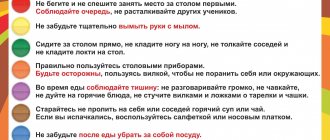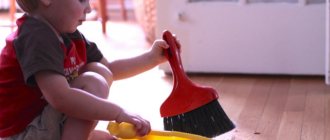The behavior of children in transport is very often discussed. Some children climb up onto the seat with their feet, interfere with other passengers, stain their clothes, and scream. This naturally annoys other passengers. Of course, you need to be a little more tolerant of children, but this does not mean that children should not follow the rules of etiquette.
Not only adults, but also children should know and observe how to behave in transport. This needs to be explained to the child, told. Before the age of 7, everything that parents do is the only right thing. It is mom and dad who create negative or positive habits and form rules. Let's try to figure out how a well-mannered person should behave.
First you need to get on the bus correctly.
- First of all, you need to explain to the child why you need to let people out first, and only then enter yourself. You can come up with a fairy tale with forest dwellers who went to the theater, but can’t get off at the right stop, since new characters are constantly being added to them. Everyone comes in and no one comes out.
When entering the transport, men let women go ahead. You need to discuss this with the little gentleman, explain that these rules of behavior are accepted in society. When entering the bus, you can offer the boy to let that girl over there. Of course, the mother will not get on public transport before the baby. But the older child may well come in after his mother. Of course, parents play the main role in education. You can repeat many times about how it is necessary to let women go ahead, but in practice the child will see something different; nothing good will come of this. Children do not develop an internal picture when one thing is said, but something completely different is done. Here the father will play a big role, letting women and children go ahead. And he tells his son that you and I are men, so we let the women go first.- When entering the transport, it would be a good idea to draw the children’s attention to the fact that they should not linger at the doors. “Let’s walk further, you see how many people are left at the stop and everyone wants to go home to the kids.”
Rules of conduct on water transport
When traveling on water transport, accompanying persons must closely monitor the pupils. Children should be given a reminder about what they are prohibited from doing on board the ship:
- independently enter or disembark the vessel;
- be on the site without a protective fence;
- enter technical and office premises;
- carry flammable substances with you;
- hang over the ship's railing.
Important! If an evacuation has been announced, the accompanying person must gather the children, calm them down and take them to the lifeboats.
Each boat carrying a minor must have two adults. You can take only the most necessary things into the boat. Each passenger must wear a life jacket. The key role of the accompanying person is to ensure that the children calmly, and preferably in a playful way, climb onto the boat and set sail from the large vessel without panic.
The general rules of conduct here are the same as in other urban transport, with the exception of some prohibitive factors.
How to sit correctly on public transport.
- One of the things that attracts public attention is the position of the child in the seat. It is necessary to explain why you should not climb with your feet on the seat, that after he gets off at the right stop, other people will get on the bus, and the seat remains dirty. It is inappropriate to play with your feet in public transport; you should not touch that lady in the white coat with your feet, because the clothes will become dirty and your mother will have to wash them.
- Another point related to the seat in public transport. It often happens that the mother stands and the baby sits. This is a fundamentally distorted situation. Sit down together! Mommy is also tired, she wants to sit. Of course, you can’t put a two-year-old toddler next to you. And those heavy bags! But older children can easily stand nearby. This is important when a child gives way to his mother, since from an early age he learns to take care of her.
It is necessary to draw children's attention to the standing old men. A boy or girl of 5–6 years old can easily seat a grandmother with sore legs or a pregnant woman. You can explain to the child that the aunt has a little baby in her tummy and it’s hard for her to stand.
Safety regulations
Rules of safe behavior must be followed in all situations. They were invented in order to preserve the health of a person who uses a bus, tram, train or plane. They apply to both adults and children, especially schoolchildren, who can independently use various transport services without parental accompaniment. Let's look at the main ones.
Memo: Rules for boarding and disembarking
- It is necessary to wait for the vehicle only at a specially equipped stopping point (stop);
- You should approach the entrance doors of a bus or train only after a complete stop; it is forbidden to jump into open doors while moving;
- If you notice that a bus or trolleybus is crowded, it is better to wait for the next one;
- Before entering a bus or other vehicle, you must let all exiting passengers pass;
- You should enter slowly, respecting the order, without trying to get ahead of everyone;
- After boarding, do not stop at the very entrance (unless you have to get off at the nearest stop), calmly walk to the middle, leaving space for those who enter after;
- There is no need to try to get off the bus or trolleybus first - it is best to wait until the main crowd of passengers leaves;
- It is advisable to cross the street after disembarking after the vehicle has left the stop;
- When boarding a tram, you must always go around it from the front, a bus or trolleybus - from the back.
Rules of behavior in nature for preschoolers
Memo: Rules for safe behavior on the road
When traveling, you should always behave with dignity and adhere to some safety rules and etiquette.
Main safety rules:
- You must not make noise, push, or cause other inconvenience to passengers;
- The transportation of flammable, flammable substances and sharp objects is prohibited in any transport. Large items (bags, backpacks) are best placed where they will not interfere with other passengers;
- The driver must not be distracted while he is working;
- It is necessary to hold on to special belts and handrails;
- In transport, it is better to stand facing to the side in the direction of travel or half-turn. You should not stop near the doors, much less lean out of the windows while moving or the doors when starting to move;
- Pets are transported in special cages and carriers; dogs are muzzled.
Memo: Rules of behavior on the bus (trolleybus) during the trip
When traveling on any transport, you must be polite to other passengers and follow the following rules:
- When entering, you need to take off your bags and backpacks so as not to touch other passengers or get them dirty;
- On the bus they don’t shake the snow off their clothes or the raindrops;
- According to generally accepted rules of behavior when boarding any transport, the first to enter are always the elderly, pregnant women, and the disabled. It is to them that schoolchildren must yield. The same must be done when leaving a public vehicle;
- It is advisable to prepare for the exit in advance (especially if there are a lot of passengers). Ask those in front: “Are you getting off at the stop?” Apologizing, ask permission to pass, and not push, silently making a way for yourself with your elbows;
- In the cabin it is necessary to give up seats to the elderly, women with small children, with heavy bags, and the disabled;
- In transport you should not push, try not to step on feet, do not lean your elbows on the person who is nearby, do not push him;
- In the cabin of a bus, trolleybus, tram they do not talk very loudly, do not lean out of the window, do not disturb passengers when exiting or entering;
- It is necessary to pay for the trip and, if necessary, show the coupon or ticket to the controller, the conductor, after the trip, the ticket is thrown into the trash bin;
- If you use a travel document, you need to keep it ready when boarding so as not to waste the conductor’s time and not cause inconvenience to other passengers when searching for it;
- If it’s uncomfortable to hold on in a crowded cabin, and you’re holding flowers or a cake, then don’t be shy and ask passengers to hold them;
- It is not customary to look closely at passengers, lean on them, or look into the phone or book of the person sitting or standing next to them;
- You cannot be rude to other passengers. If a remark is made about something, you should take note of it and try to improve;
- You cannot dirty the seats, climb on them with your feet, paint them, eat ice cream, cakes, comb your hair, clean your nails, laugh loudly, talk, discuss problems publicly, and much more.
Safe behavior of the child at home, in the apartment and in the entrance
You cannot eat ice cream or cake on transport.
It is necessary to explain to children that transport is not a canteen. Firstly, it is not hygienic. There are a lot of bacteria around, many hands touch the handrails and there is a high probability of intestinal diseases. Secondly, you can dirty innocent people. You can also make up a fairy tale on the fly about a baby elephant (or a bear cub, it doesn’t matter) who was eating ice cream in a trolleybus; it began to melt and drip directly onto the passengers standing nearby. Another point is that the driver can brake if necessary, and all the contents have a high risk of falling out on a nearby sitting or standing neighbor. It would also be useful to remind you that you should not throw candy wrappers. We must try to convey to the child that it is clean where there is no litter! These are the rules!
Fines for passengers in 2022
The Code of Administrative Offenses provides for 2 options for fines for passengers:
- Article 12.29, part 1 – warning or 500 rubles. Imposed for any violation of the rules that did not interfere with other road users. For example, such a fine threatens a passenger who does not wear a seat belt.
- Article 12.30 part 1 – 1,000 rubles. Imposed if the passenger interferes with the movement of vehicles. For example, he was not convinced that there were no cars and opened the car door from the side of the roadway.
This concludes the review of the rules for passengers.
Sources
- https://vospitanie.guru/povedenie/v-transporte
- https://etiketclub.ru/etiket-v-transporte
- https://www.tutu.ru/2read/bus/bus_rules/
- https://vplate.ru/etiket/pravila-povedeniya-v-obshchestvennom-transporte/
- https://fireman.club/statyi-polzovateley/pravila-bezopasnosti-v-obshhestvennom-transporte/
- https://pddmaster.ru/pdd/passazhir-pdd.html
Rules for exiting public transport.
Well, we finally got there, it seemed like we could breathe easy. But it was not there. Etiquette says that a man should shake hands with a woman from a vehicle. Of course, a three-year-old toddler cannot do this due to his small age, but an older child, 6–7 years old, can easily do this. How nice it is when a boy shakes his mother's hand on the way out. He automatically feels like an adult, independent. He enjoys taking care of anyone. We need to seize the moment! Because it will be more difficult for older people. And the mother will be very pleased that her son is growing up so gallant and caring.
In conclusion, we can say that our children come to us as a blank slate, and what happens to them next is up to the parents. By teaching how to follow basic rules of behavior in transport, parents thereby provide themselves with a rear. After all, as we know, what goes around comes around. And of course, it is impossible to teach a child one thing in words and another in deeds. Therefore, it would be a good idea for adults to familiarize themselves with these rules.
leave a comment
Rules of conduct on railway transport
Traveling by rail is one of the most popular options for those who have small children. The convenience lies in the fact that even if you travel in a reserved seat car, children are always in sight.
Child and train
He can walk and run around the carriage, eat, drink and even sleep. You can play various games with your baby. But here, too, there are points that a preschooler should know before traveling:
- You can move to the desired platform only through special paths and transitions. Walking on rails and sleepers is prohibited.
- You cannot run in front of the cars or crawl under them. The braking distance of the train reaches 1 km, and the locomotive driver cannot see who is under the train.
- You cannot jump on or off a moving train.
- It is prohibited to play on platforms and paths.
- Very young children should be in the arms of adults.
- Do not go beyond the safety line on the platform.
On a note! If all the rules for traveling by rail are followed, children will have an exciting and safe journey through forests and mountains, seas and plains.
Rules of conduct in the air
From the age of two, children on planes already have 20 kg of free baggage. This is a nice bonus when flying. To get to the plane, you need to take a bus, which will take everyone to the boarding point. There is no general check of the presence of those present, since usually a group of preschoolers is not carried on airplanes.
Children on a plane
General safety rules do not differ from the rules for traveling on a bus or trolleybus, except for the point where you need to turn off electronic equipment.
Familiarization with the norms of behavior on the road from an early age teaches kindergarteners to treat dangerous areas of the street responsibly. With the help of games, students learn to pay attention to road signs. Also, from an early age, children are taught etiquette and politeness.










